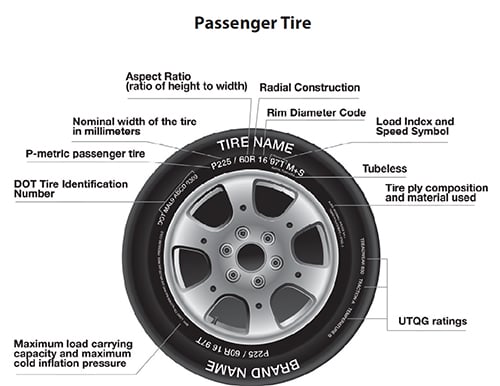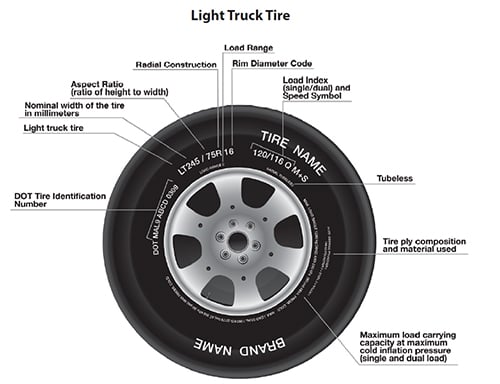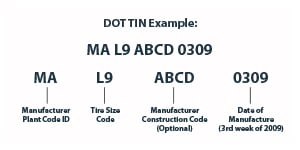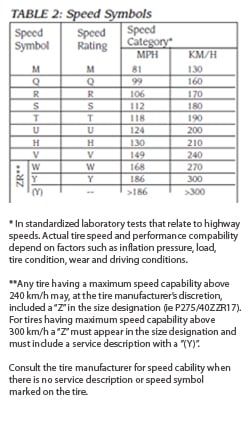Your Tire's Information
Tires have very useful information molded onto their sidewalls. It shows the brand and model name of the tire, its size, whether it is tubeless or tube type, the maximum load and the maximum inflation, safety warning(s), and much more.


Load Index - The load index is a numerical code associated with the maximum load a tire can carry at the speed indicated by its speed symbol under specified service conditions. The load index should not be used independently to determine replacement tire acceptability for load capacity.
Speed Symbol - The speed symbol is also known as a “speed rating.”
P225/60R16 97T – (Passenger Example) Size marking and service description (load index and speed symbol) for a P-Metric speed-rated passenger tire.
LT245/75R16 120/116Q Load Range E – (Light Truck Example) Size marking, service description (load index and speed symbol), and load range for a metric light truck tire. The load range identifies the tire's load and inflation limits.
Max Load 730 kg (1609 lbs) and 240 kPa (35 psi) Max Pressure Cold –(Passenger Example) Indicates maximum load and maximum cold inflation pressure of the tire. Sidewall markings are given in both metric and English Engineering units. Follow tire inflation pressure recommendations on the vehicle’s tire placard, certification label, or in the owner’s manual.
Max Load Single 1380 kg (3042 lbs) at 550 kPa (80 psi) Max Pressure Cold
Max Load Dual 1260 kg (2778 lbs) at 550 kPa (80 psi) Max Pressure Cold – (Light Truck Example) Indicates the maximum load of the tire and corresponding maximum cold inflation pressure for that load when used in a single or dual configuration. Sidewall markings are given in both metric and English Engineering units. Follow tire inflation pressure recommendations on the vehicle’s tire placard, certification label, or in the owner’s manual.

DOT MA L9 ABCD 0309 – The “DOT” symbol certifies the tire manufacturer's compliance with U.S. Department of Transportation (U.S. DOT) tire-safety performance standards. Next to these letters is the tire identification number (TIN) – also known as the tire “serial” number. The first two characters are the factory code indicating where the tire was made. The last four digits are numbers identifying the week and year of manufacture (example: "0309" means the third week of the year 2009). If a tire DOT ends in only three (3) digits, the tire was manufactured before January 2000 and should be removed from service and be scrapped because it is over 10 years old.
Plies/Fabric Information – The ply/fabric information identifies the number of plies and type of cord materials in the tire tread and sidewall areas.
Radial – A tire with a radial construction must show the word “RADIAL” on the sidewall. A radial tire is also indicated by the character “R” in the size designation.
Tubeless – The tire must be marked either "tubeless" or "tube type."
M + S – This mark is commonly found on “all-season” and winter tires. In several formats, the letters "M" and "S" indicate the tire is intended for limited mud and snow service. Other formats include: "MS," "M/S," or "M&S."
 Mountain-Snowflake Symbol –
This mark is commonly found on winter/snow tires. Tires that meet the RMA definition for passenger and light-truck tires for use in severe snow conditions are marked on at least one sidewall with the letters "M" and "S" (as stated above), plus the mountain-snowflake symbol.
Mountain-Snowflake Symbol –
This mark is commonly found on winter/snow tires. Tires that meet the RMA definition for passenger and light-truck tires for use in severe snow conditions are marked on at least one sidewall with the letters "M" and "S" (as stated above), plus the mountain-snowflake symbol.

Speed Symbol
The speed symbol, also known as a speed rating, indicates the speed category at which the tire can carry a load corresponding to its load index under specified service conditions. Speed ratings are based on laboratory tests that relate to performance on the road, but are not applicable if tires are underinflated, overloaded, worn out, damaged, or altered.
Although a tire may be speed rated, Mastercraft® Tires does not endorse the operation of any vehicle in an unsafe or unlawful manner. Furthermore, tire speed ratings do not imply that a vehicle can be safely driven at the maximum speed for which the tire is rated, particularly under adverse road and weather conditions or if the vehicle has unusual characteristics.
Your tire’s Tire Identification Number (TIN)
A tire's plant of origin and date of manufacture are located on each tire. These can be determined by examining the series of letters and numbers called the Tire Identification Number (TIN), which follows the letters "DOT" on the tire sidewall
In order to find the week and year of production for tires manufactured after 1999, look at the last four numbers of the TIN. It will identify the week and year in which the tire was manufactured. The first two numbers identify the week, and the last two numbers identify the year of manufacture. Thus, a TIN ending with "3815" indicates that the tire was made during the 38th week of 2015 and would appear as DOTXXXXXXX3815 on the sidewall of the tire.

The Uniform Tire Quality Grading (UTQG)
The Uniform Tire Quality Grading (UTQG) is a system developed by the Department of Transportation that helps consumers compare tires in the areas of treadwear traction and temperature. Here is an example: a tire with a UTQG of 300 AB. The 300 is treadwear, which represents the tire's comparative wear when measured against the government-mandated tire, which is rated at 100. So, this tire wore three times longer than the control tire. Because of variations in operating conditions, the treadwear grade cannot be used to predict actual wear-out mileage; it can be used to predict the relative wear rate of tires with different UTQG wear rates. Traction and temperature are graded A (superior), B (good), or C (average). Traction indicates the level of grip the tire possesses.
Temperature rating deals with the tire’s ability to disperse built-up heat. Heat causes rubber to deteriorate over time, so dispersing heat increases tire life.
Each tire manufacturer determines UTQG ratings for their products.
Temperature
The temperature grades, from highest to lowest, are A, B, and C. These represent the tire's resistance to the generation of heat when tested under controlled conditions on a specified indoor laboratory test wheel. Temperature considerations must be made based on conditions, regional climate ranges, and extreme condition variances.
Traction
Traction grades, from highest to lowest, are AA, A, B, and C. They represent the tire's ability to stop on wet pavement, as measured under controlled conditions on specified government test surfaces of asphalt and concrete.
Treadwear
The treadwear grade is a comparative rating based on the wear rate of the tire when tested under controlled conditions on a specified government test track. A tire graded 200 would wear twice as long on the government test course under specified test conditions, as one graded 100. It is wrong to link treadwear grades with your projected tire mileage. The relative performance of tires depends on the actual conditions of their use and may vary due to driving habits, service practices, differences in road characteristics, and climate.